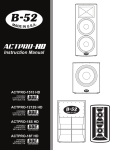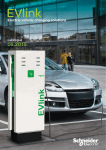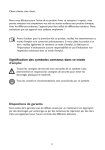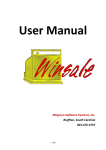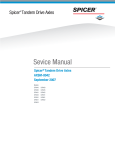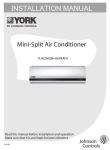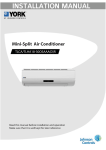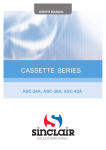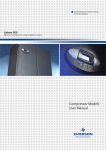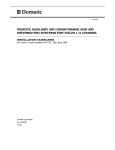Download York 076-090 Specifications
Transcript
<-- SPLIT SYSTEM YORK ® <-- Index Page General description 5 - Nomenclature 5 Technical specifications 5 - Mechanical specifications of outdoor units AHO-F - Mechanical specifications of indoor unit CHI-800 - Table of variations - Physical data - Rated performance data - Testing conditions - Correction factors - Cooling capacities sensitives - CHI-800 fan performance 5 5 6 7 8 8 8 8 - 10 10 Installation instructions 11 - 11 11 11 11 11 11 12 12 12 12 2 General comments Protection of the environment Warning signals Transportation Location Empty spaces Air ducts (indoor unit) Drainage connections Valves and refrigerant load Emptying and dehydrating Page - Leakage detection Refrigerant load Adjusting the refrigerant load Refrigerant interconnections Diameter of the interconnecting tubing Insulation of tubing Wiring installation - Electrical characteristics - Limits of use - Before final approval of the installation 12 12 12 12 13 13 13 13 - 14 14 14 Instructions for use 15 - General information - Ambient thermostat 15 15 Maintenance 16 - 16 16 16 16 16 Filling the drainage siphon Discharge of the indoor units with ducts Cleaning the filters Cleaning the outdoor unit Checking the tension of the belts General dimensions 17 - 18 <-- General description The units in the SOC range are the outdoor units of a splittype air conditioner; they are fitted with a vertical discharge axial fan and have been designed for installation outdoors. Units SOC-076 to 180 are compatible with indoor units SIC-076 to 60. In winter they can provide heat if the indoor unit SIC is fitted with an electric heater or a hot water coil (optional accessories). The outdoor unit SOC-240 is compatible with the SIC-240. For operation, these units must be connected, electrically and with regard to the refrigerant, to the corresponding indoor unit. Nomenclature Horizontal outdoor unit with axial fan oversized mechanical components and a low-consumption motor. It is delivered with a charge of special oil which prevents the formation of foam, and with an oil heater element. Models SOC-090 and SOC-180 incorporate Scroll rotary compressors. Remaining models incorporate reciprocating compressors. Compressor heater Keeps the crankcase oil hot to ease start-ups and prevent oil from being carried away from the compressor. Coils Large heat transfer area coils, made of copper tubes and 'slit' aluminium fins. Fans Axial fans with free air discharge, without ductwork. Quiet operation and three speeds available. Casing Made of aluminium-zinc galvanized steel sheet, finished with baked-on polymerized powder paint. Rated power: 076 090 120 150 180 240 = = = = = = 19 700 W 27 600 W 35 800 W 40 200 W 55 200 W 71 600 W Refrigerant circuit Made of brazed copper tubes. Units are delivered dehydrated and after having passed the relevant pressure and leak detection tests. Electrical and control wiring system Highly reliable integrated circuits. Their compact size permit easy and fast servicing. It complies with the European regulations currently in force. Mechanical specifications of indoor unit SIC240 F = Cooling only Voltage: 22 = 220/240.3.50 38 = 380/415.3.50 Indoor unit SIC-240 is compatible with either of the cool only outdoor units SOC-240 or heat pump SOH-240. The main features of this unit are as follows: Fan Double fan type with common shaft, pulley and belt drive. The fan pulley is of the removable tapered core type. The motor is mounted on a tensioner base which makes maintenance operations easier. The fan motor assembly is resiliently mounted on spring isolators to avoid tranmission of vibration and noes. Coil Made of copper tubes and aluminium 'slit' fins. Design level SOC 120 F 38 A Technical specifications Control box Fully accessible from outside. Casing Made of aluminium-zinc galvanized steel sheet highly resistant to corrosion, painted with baked-on epoxy-polyester powder enamel. It features a shape framework which allows for all its components to be easily accessible. It can take up an electric heater (optional accessory). With integral filter rack and air filter. Mechanical specifications of outdoor units SOC Refrigerant circuit Compressor Vertical hermetic type, mounted on vibration isolators, with Double circuit with directional connections and calibrated orifice type. 3 <-Table of variations SOC-076 220/240.3.50 380/415.3.50 SIC-076 220/240.3.50 380/415.3.50 SOC-090 220/240.2.50 380/415.3.50 SIC-090/120 220/240.3.50 380/415.3.50 SOC-120 220/240.3.50 380/415.3.50 SIC-150 380/415.3.50 SOC-150 380/415.3.50 SOC-180 380/415.3.50 SOC-240 380/415.3.50 4 SIC-180 380/415.3.50 SIC-240 380/415.3.50 <-- Physical data Outdoor units Model SOC 076 SOC 090 SOC 120 1 1 1 Reciprocating Scroll 8.4 10.2 Quantity Type SOC 150 SOC 180 SOC 240 2 2 2 Reciprocating Reciprocating Scroll Reciprocating 12.2 2 x 8.4 2 x 10.2 2 x 12.2 Compressor Nominal power kW Power supply V.ph.Hz Power rating W Number of fans Outdoor fan Power supply 380/415.3.50 216 216 216 216 216 216 2 2 3 4 6 6 V.ph.Hz. Propeller width Quantity Indoor coil 220/240.3.50 or 380/415.3.50 Rows deep x high Tube O. D. 220/240.1.50 510 510 510 510 510 510 2 2 2 2 2 2 4 x 28 4 x 28 4 x 28 4 x 56 4 x 56 4 x 56 3/8" 3/8" 3/8" 3/8" 3/8" 3/8" High mm 1 030 1 030 1 030 1 495 1 495 1 495 Wide mm 1 580 1 860 2 230 1 690 1 975 2 150 Deep mm 950 950 950 1 547 1 547 1 547 Net weight Kg 250 292 330 590 715 750 Gross weight Kg 259 302 340 595 720 755 Shipping dimensions of outdoor unit Indoor units Model SIC 240 *Number of fan wheels 2 Wheel width mm 380 Long mm 380 *Motor power rating W 3 000 m3 /h 14 240 m3 /s 3.95 Fan Nominal flow rate Available pressure mm WG 10 Pa 98 Rows deep x high 4 x 33 Coil Tube O. D. 3/8" Net weight kg 337 Gross weight kg 427 *A single motor drives the fan wheels. 5 <-Rated performance data Summer Outoor unit Indoor unit Cooling capacity W Available pressure indoor blower Pa Consumption W SOC-076 SIC-076 19 700 9 120 62 SOC-090 SIC-090/120 27 600 11 200 62 SOC-120 SIC-090/12 35 800 14 000 62 SOC-150 SIC-150 40 200 17 400 80 SOC-180 SIC-180 55 200 22 400 80 SOC-240 SIC-240 71 600 28 000 80 Note: SIC units have their own information available. Testing conditions Summer Length of interconnection line Voltage V. 400 Outdoor temperature °C 7.5 metres Indoor temperature °C DB WB DB WB 35 24 27 19 Note: DB = Dry Bulb, WB = Wet Bulb. Correction of the real entering outdoor coil air temperature for flow rates other than nominal. Correction factors Correction factors for cooling capacities Cooling capacity correction factors according to indoor and outdoor temperatures. % Flow rate 80 90 100 110 120 130 Total capacity 0.960 0.980 1 1.016 1.032 1.046 Sensible capacity 0.945 0.973 1 1.038 1.075 1.118 Comp. power input 0.980 0.990 1 1.009 1.017 1.025 % Flow rate Correction in °C over the real entering outdoor coil air temperature 70 80 90 100 110 5 3 1.5 0 -1 120 130 -2 -2.5 Cooling capacities sensitives Sensitive capacity (W/h) Model Outdoor air dry temperature °C (DB) 25 SOC-076/ SIC-076 35 45 6 Air intake humid temperature °C (WB) Compressor absorbed power Temperautre air going to indoor unit °C (DB) Total capacity 22 24 27 29 W/h W/h W/h W/h W/h kW 22 23 640 7 077 10 212 14 915 18 054 5.72 19.5 21 276 11 006 14 141 18 844 21 276 5.99 17 19 700 15 157 18 292 19 700 19 700 6.27 22 21 867 6 490 9 625 14 328 17 463 6.47 19.5 19 700 10 435 13 570 18 273 19 700 6.81 17 18 124 13 687 16 823 18 124 18 124 7.15 22 19 700 5 835 8 971 13 674 16 809 7.49 19.5 17 730 9 782 12 918 17 621 17 730 7.83 17 16 154 13 756 16 154 16 154 16 154 8.17 <-- Cooling capacities sensitives Sensitive capacity (W/h) Model Outdoor air dry temperature °C (DB) 25 SOC-090/ SIC-090/120 35 45 25 SOC-120/ SIC-090/120 35 45 25 SOC-150/ SIC-150 35 45 Air intake humid temperature °C (WB) Total capacity Compressor absorbed power Temperature air going to indoor unit °C (DB) 22 24 27 29 W/h W/h W/h W/h W/h kW 22 34 800 10 426 15 008 21 879 26 466 6.24 19.5 31 320 16 167 20 748 27 619 31 320 6.54 17 29 000 22 233 26 814 29 000 29 000 6.84 22 32 190 9 561 14 142 21 014 25 595 7.06 19.5 29 000 15 325 19 906 26 777 29 000 7.43 17 26 680 20 062 24 643 26 680 26 680 7.80 22 29 000 8 597 13 178 20 050 24 631 8.17 19.5 26 100 14 363 18 944 25 816 26 100 8.54 17 23 780 20 168 23 780 23 780 23 780 8.92 22 39 600 12 050 16 631 23 503 28 091 9.63 19.5 35 640 17 763 22 344 29 215 33 804 10.08 17 33 000 23 855 28 436 33 000 33 000 10.54 22 36 630 11 041 15 622 22 493 27 074 10.89 19.5 33 000 16 783 21 364 28 236 32 817 11.46 17 30 360 21 363 25 944 30 360 30 360 12.03 22 33 000 9 917 14 499 21 370 25 951 12.61 19.5 29 700 15 665 20 246 27 118 29 700 13.18 17 27 060 21 459 26 040 27 060 27 060 13.75 22 48 240 14 518 20 628 29 793 35 911 12.14 19.5 43 416 22 164 28 274 37 438 43 416 12.72 17 40 200 30 264 36 374 40 200 40 200 13.29 22 44 622 13 310 19 420 28 584 34 694 13.73 19.5 40 200 20 989 27 099 36 264 40 200 14.45 17 36 984 27 253 33 363 36 984 36 984 15.17 22 40 200 11 964 18 074 27 239 33 349 15.90 19.5 36 180 19 648 25 758 34 922 36 180 16.62 17 32 964 27 386 32 964 32 964 32 964 17.34 7 <-Cooling capacities sensitives Sensitive capacity (W/h) Model Outdoor air dry temperature °C (DB) Air intake humid temperature °C (WB) 25 SOC-180/ SIC-180 35 45 25 SOC-240/ SIC-240 35 45 Total capacity Compressor absorbed power Temperature air going to indoor unit °C (TS) 22 24 27 29 W/h W/h W/h W/h W/h kW 22 64 800 19 662 27 333 38 841 46 524 12.60 19.5 58 320 29 237 36 909 48 417 56 102 13.20 17 54 000 39 432 47 104 54 000 54 000 13.80 22 59 940 18 017 25 689 37 197 44 869 14.25 19.5 54 000 27 641 35 313 46 820 54 000 15.00 17 49 680 35 362 43 034 49 680 49 680 15.75 22 54 000 16 187 23 859 35 367 43 039 16.50 19.5 48 600 25 819 33 491 44 999 48 600 17.25 17 44 280 35 525 43 197 44 280 44 280 18.00 22 81 600 24 781 34 373 48 762 58 368 19.65 19.5 73 440 36 750 46 343 60 732 70 340 20.58 17 68 000 49 500 59 092 68 000 68 000 21.52 22 75 480 22 707 32 300 46 688 56 281 22.22 19.5 68 000 34 737 44 330 58 718 68 000 23.39 17 62 560 47 088 56 681 62 560 62 560 24.56 22 68 000 20 400 29 992 44 381 53 973 25.73 19.5 61 200 32 441 42 033 56 422 61 200 26.90 17 55 760 44 575 54 168 55 760 55 760 28.07 SIC-240 fan performance Available static pressure Air flow rate Power input Model mm WG Pa m 3/h m3/s W 19.9 195 10 000 2.78 1 395 18 176 11 000 3.05 1 550 16.1 158 12 000 3.33 1 565 13.4 131 13 000 3.61 1 905 10.7 105 14 000 3.89 2 050 7.4 73 15 000 4.16 2 240 3.9 38 16 000 4.44 2 430 0 0 17 000 4.72 2 675 SIC-240 8 <-- Installation instructions General comments The SOC series units are outdoor units of a split air conditioner which are equipped with an axial and vertical discharge fan, and are to be installed directly outdoors. For operation, these units must be connected, electrically and with regard to the refrigerant, to the corresponding indoor unit. Attention: Fan in operation. Protection of the environment Packing The packing material is recyclable. It should be disposed of in accordance with the residual collection regulations established. Attention: No to touch hot surfaces. Disposal of the unit After a long service life, and upon disassembling the unit, its components should be recuperated ecologically. The cooling circuit is full of HCFC-22 refrigerant that should be salvaged and, finally, returned to the gas manufacturer for recycling. Oil will remain in the airtight compressor and, therefore, it will be returned along with the sealed circuit. The air conditioning unit will be deposited wherever established by the local authorities for its selective disposal. Attention: Possible gas leakage due to inadequate handling. Warning signals The following signs indicate the presence of potentially dangerous conditions for users or service personnel. Whenever found on the unit itself, keep in mind the warning indicated by each one. Attention: Transmission by belt and pulley. This sign indicates an electrical risk or danger. Transportation Attention: The unit has a remote control system and can start automatically. Two minutes prior to having access to the interior, the power supply should be disconnected so as to avoid any contact with the fan turbine. The outdoor units should always be transported in vertical position so as to avoid oil leakage from the compressor. If, for any reason, this position has to be changed, it should be done only for the time strictly necessary. Location The location chosen should allow permanent access for service maintenance, either through the side panels or the rear panel. The outdoor unit should be installed directly outdoors. Empty spaces Attention: It is compulsory to read the instructions prior to any handling. Empty space should be left in the installation of each unit for the following: a) Outdoor unit air intake and discharge. b) Connection of the drainage tubing and wiring. c) Air ducts. d) Maintenance service. e) Electrical supply. For proper operation, the minimum distances indicated in the general dimensions drawings should always be respected with regard to obstacles that could obstruct the free circulation of air, or any service work. 9 <-Air ducts (indoor unit) 1.- Connect the ducts, isolating from the unit by means of a flexible hose, preferably of a non-combustible material, so as to avoid transmitting the vibration of the unit itself. If the ducts are made of flexible material they do not transmit vibrations. 2.- It is advisable to place a damper at each discharge duct derivation so as to be able to carry out a correct balance of the system. 3.- Make sure there is easy access for cleaning and changing the air filters. Drainage connections Install the drainage tubing of each tray through a siphon. Leave a minimum height difference of 75 mm. between the height of the connection to the unit and the line after the siphon (see figure). This is to avoid that the pressure drop produced by the fan may not interfere with the emptying of the tray. There should be an access so that, at the beginning of each season, the siphon may be filled with water. The drainage line should have a minimum inclination of 2 cms. per meter of total length. system should be completely eliminated, as these have undesirable effects, as indicated in the list below. - High pressure increase. - Power consumption increase. - Equipment performance decrease. - The water contained in the air may freeze and block the capillaries. - The water may corrode certain parts of the circuit and deteriorate the compressor. Emptying and dehydration should be carried out by means of a vacuum pump. The vacuum needed is 200 microns (0.2 mm. Hg.). Connection of the vacuum pump to the cooling circuit should be made at the 1/4" SAE connections furnished for this purpose, and with the valves closed. This will allow emptying and dehydrating the units and interconnecting tubing. The SOC-076 and SOC-150 units are supplied preloaded with refrigerant and does not need to be emptied. Leakage detection Leakage detection in the circuit that joins the two units will be carried out by using R-22 refrigerant and the aid of a detector. Refrigerant load SLOPE 2% MINIMUM 75 mm The nominal refrigerant load is calculated for a tubing length of 7.5 meters. Model PLUG Nominal load R-22 kg Number of circuits Diameter liquid line Additional load grs. (per meter) SOC-076/SIC-076 7.1 1 1/2" (12.7 mm) 104 SOC-090/SIC-090/120 9.4 1 5/8" (15.87 mm) 170 SOC-120/SIC-090/120 11.45 1 5/8" (15.87 mm) 170 SOC-150/SIC-150 7 2 1/2" (12.7 mm) 104 SOC-180/SIC-180 9 2 5/8" (15.87 mm) 170 SOC-240/SIC-240 11.5 2 5/8" (15.87 mm) 170 Adjusting the refrigerant load Valves and refrigerant load The SOC-076 unit has only one circuit and is supplied with two valves. The SOC-150 unit has two circuits and is supplied with four valves. These valves are supplied closed and with an entire refrigerant load in the outdoor unit (pumpdown). Before starting the unit, make sure the valves are completely open. The SOC-090 and SOC-120 units have only one circuit while the SOC-180 and SOC-240 units have two circuits. These units are suppied without valves, but with connections ready for welding. The refrigerant load must be carried out completely on site. See refrigerant load in the corresponding section, and follow the recommendations made in the Refrigerant Interconnections and Refrigerant Load Process sections. Emptying and dehydrating Air does not act as a refrigerant as it cannot be liquified by the compressor. The air and humidity remaining in the cooling 10 For lengths of tubing of over or under 7.5 m., the nominal refrigerant load should be increased or decreased by the grammes indicated above, in accordance to as to whether the length of the liquid tubing has been increased or decreased. Refrigerant interconnections When installing the tubing that interconnect both units, take special care in keeping the tubing to be used clean and dry prior to installation. The following recommendations are advisable: 1- Use only refrigerant quality copper tubing. 2- Do not work outdoors in the rain. 3- The ends of the tubing should remain closed during installation. 4- Do not leave neither the drying filters nor the compressor out in the open for more than one or two minutes. 5- For welding use low-solidus point rods with a minimum 5% silver content. 6- When welding, and while the tubing is still hot, a flow of dry nitrogen should be maintained so as to avoid the forming of oxides and scales in the interior which could cause <-- contamination and obstructions. 7- For copper-copper joints do not use strippers. Wiring installation Diameter of the interconnecting tubing Diameter gas line (wide tubing) Model Diameter liquid line (narrow tubing) SOC-076 & 150 1/2" (12.7 mm) 11/8 " (28.5 mm) SOC-090, 120, 180 & 240 The air conditioners are supplied with a control box to which the power supply is to be connected through a main switch with fuses, or an automatic switch. The electric resistances, if any, should be connected to independent power supplies and switches, and not to the ones that feed the unit. In every case the established national regulations should be applied. 5/8" (15.87 mm) Insulation of tubing The gas tubing (wide tubing) should be isolated from the refrigerant. The insulation should have specific characteristics: be easy to install, resistant to aging, waterproof, fireproof and have a thickness of at least 12 mm. So as to avoid deterioration due to the sun, it is convenient to paint same with water-based enamel. Loose cables can cause overheating of the terminals, or incorrect operation of the unit. A fire hazard may also exist. Therefore, make sure that all cables are connected tightly. CAUTION Do not supply power to the unit and do not start up operations until the tubing and electrical connections with the outdoor unit have been completed. Make sure that the electrical supply is correctly connected to the units, as shown in the wiring diagrams. After having insulated the tubing, do not attempt to bend it excessively as it could crack or break. Electrical characteristics Outdoor units Consumption A Power supply V.ph.Hz. Compressor Model Compressor Fan Power supply cable section Automatic Switch Fan Start Nominal Maximum Start Nominal mm2 A 220/240.3.50 220/240.1.50 183 23.3 27.3 7 2.4 10 50 380/415.3.50 220/240.1.50 91 13.5 15.8 7 2.4 6 32 220/240.3.50 220/240.1.50 170 25.6 30.6 7 2.2 16 63 380/415.3.50 220/240.1.50 105 14.8 17.7 7 2.2 10 40 220/240.3.50 220/240.1.50 267 36.5 42.5 12 3.4 25 80 380/415.3.50 220/240.1.50 135 21.1 24.6 12 3.4 10 50 SOC-150 380/415.3.50 220/240.1.50 2 x 91 2 x 13.5 2 x 15.8 2x7 2 x 2.2 16 63 SOC-180 380/415.3.50 220/240.1.50 2 x 105 2 x 14.8 2 x 17.7 2x7 2 x 2.3 25 100 SOC-240 380/415.3.50 220/240.1.50 2 x 135 2 x 21.1 2 x 24.6 2 x 12 2 x 3.4 25 100 SOC-076 SOC-090 SOC-120 11 <-- Indoor units Power supply V.ph.Hz. Consumption A Fan Model Power supply cable section Automatic switch mm2 A Fan Start Nominal 220/240.3.50 14 5,2 4 x 2.5 - 380/415.3.50 7 2 4 x 2.5 - 220/240.3.50 23 5.5 4 x 2.5 - 380/415.3.50 10 3.2 4 x 2.5 - 220/240.3.50 23 5.7 4 x 2.5 - 380/415.3.50 10 3.3 4 x 2.5 - SIC-150 380/415.3.50 10 3.5 4 x 2.5 - SIC-180 380/415.3.50 27 7.1 4 x 2.5 15 SIC-240 380/415.3.50 30 6.4 4 x 2.5 15 SIC-076 SOC-090/SIC-090/120 SOC-120/SOC-090/120 Limits of use Air intake temperature to evaporating unit °C Voltage limits Nom. 220/240 V Minimum Maximum 198 254 Notes: WB -Wet Bulb, Nom. 380/415 V Temperature WB Air intake temperature to condensing unit °C Temperature DB Temperature DB Minimum Maximum Minimum Maximum Minimum Maximum Minimum Maximum 342 436 14 23 19 32 19 46 DB -Dry Bulb. Before final approval of the installation Verify: - Voltage is always between 198254 V., or 342-436 V. - The section of the power supply cable is, at least, that recommended in the corresponding wiring diagrams. - The need to clean the air filter periodically has been notified. - Condensation drainage is carried out perfectly and there are no leaks in the water circuit. - The guarantee card has been filled out. - Maintenance instructions have been given, or a regular servicing contract has been signed. - Operating instructions have been given to the user. 12 <-- Dial set to the desired temperature index. Instructions for use General information The start up and automatic temperature setting is carried out by means of the ambient thermostat, at 24 volts, specially designed for these units. Depending upon the model of your air conditioner, same will be controlled by the corresponding thermostat. The thermostat models may be: T-11 (one cooling phase and one heating phase), T-12 (one cooling phase and two heating p h a s e s ) , T-22 (two cooling phases and two heating phases). The instruction manual will allow you to become familiar with the operation of any and all of these. Ambient thermostat The thermostat for the SOC air conditioners are designed to give a correct ambient temperature control, and have all necessary controls for start up, stopping, selection and automatic temperature setting. It is equipped with a thermometric indicator that permanently shows the ambient tem- AMBIENT TEMPERATURE INDICATOR (THERMOMETER) AUTO VENT CONT CAL ..... ..... ..... ..... 10 15 20 25 30 ..... ..... ..... ..... PARO Starting process for the T-22 thermostat The thermostat has three basic operating modes: a) For ventilating only: Lever A set to ON. Lever B set to OFF. Dial at any setting. b) Summer air conditioning (cooling): Lever A set to ON. Lever B set to COOL. Dial set to the desired temperature index. c) Winter air conditioning (heating): (with heating battery, optional accessory) Lever A set to ON. Lever B set to HEAT. Dial set to the desired temperature index. perature of the room being conditioned. LEVEL "A" In the "OFF" position the cooling unit is inoperative. When lever A is set to "CONT", only the fan operates. At the "REF" or "CAL" and "AUTO" settings, the fan starts to operate simultaneously with the compressor or the electric heater, if installed (optional accessory), in accordance with the thermostat index and the ambient temperature. The unit is completely inoperative when lever A is set to "AUTO" and lever B to "OFF". LEVEL "B" REF In the "OFF" position the cooling unit is inoperative. When lever A is set to "ON", only the fan operates. At the "COOL" or "HEAT" and "AUTO" settings, the fan starts to operate simultaneously with the compressor or the electric heater, if installed (optional accessory), in accordance with the thermostat index and the ambient temperature. The unit is completely inoperative when lever A DIAL TO SET THE WINTER TEMPERATURE (HEATING) SET TEMPERATURE INDEX DIAL TO SET THE SUMMER TEMPERATURE (COOLING) TEMPERATURE SETTING DIAL SET TEMPERATURE INDEX SET TEMPERATURE INDEX COOL HEAT T-11 and T-12 thermostat Starting process for the T-11 and T-12 thermostats The thermostat has three basic operating modes: a) For ventilating only: Lever A set to CONT. Lever B set to OFF. Dial at any setting. C 10 15 20 25 FAN AUTO b) Summer air conditioning (cooling): Lever A set to CONT or AUTO. Lever B set to REF. Dial set to the desired temperature index. ON LEVEL "A" HEAT OFF COOL LEVEL "B" AMBIENT TEMPERATURE INDICATOR (THERMOMETER) c) Winter air conditioning (heating): (with heating battery, optional accessory) Lever A set to CONT or AUTO. Lever B set to CAL. 13 <-- is set to "AUTO" and lever B to "OFF". T-22 thermostat Maintenance Keep the battery filters in good condition, checking them at least once a month. If the filters are dirty, air flow and equipment performance are reduced. Cleaning the outdoor unit CAUTION Dirt should not be allowed to accumulate in the outdoor battery. It should be cleaned as frequently as needed, Clean the casing and the grill of the indoor unit either with a vacuum cleaner or a rag soaked in a soft liquid detergent. CAUTION Do not use water to clean the indoor unit. Water may damage the internal components and cause electrical discharges. Filling the drainage siphon So as to avoid having problems with the condensed water, we recommend that, prior to start up and before the beginning of each season, the drainage siphon be filled with water so as to avoid air being sucked in through this tubing. Discharge of the indoor units with ducts with a brush, vacuum cleaner or detergent. For safety reasons, make sure to turn the air conditioner off, and unplug the power supply, prior to cleaning. Check the outdoor unit periodically to see if the air inlet or outlet are clogged by dirt or leaves, etc. The internal coil and other components of the outdoor unit must also be periodically cleaned. Contact your concessionary or maintenance service. CAUTION Checking the tension of the belts The tension and wear of the belts of the motors should be CAUTION The discharge of the indoor units equipped for ducts are supplied without a protecting grill. When carrying out maintenance services, keep this in mind. In the case of installing an indoor unit with free discharge and equipped for ducts, the outlet opening should be protected with a grill. The lack of this protection could provoke damage caused by the fan turbine. Cleaning the filters checked, and the belts changed if necessary. Before carrying this operation out, disconnect the main supply switch. For safety reasons, make sure to turn the air conditioner off, and unplug the power supply, prior to checking the fan motor belts. 14 General dimensions mm SIC-240 EMPTY SPACE 600 827 203 8 25 142 .5 985 633 758 404 473 225 473 381 93 .5 363 2323 80 142 40 EMPTY ESPACE 600 "A" DETAIL EMPTY SPACE 600 DRAINAGE R 3/4" "A" DETAIL 236 140 104 5 37 163 37 100 572 LIQUID CONNECTION 5/8" GAS CONNECTION 11/8" 40 28 SOC-076, 090 & 120 945 <-- EMPTY SPACE 600 GAS TUBING CONNECTION ACCESS 11/8" D. 13.7 LIQUID TUBING CONNECTION ACCESS (D) EMPTY SPACE 600 EMPTY SPACE 1000 C DRAINAGE CONNECTION 70 15 A B C Models 15 890 A B C D SOC-076 1 490 970 260 1/2" SOC-090 1 775 1 255 260 5/8" SOC-120 2 150 1 580 285 5/8" 15 920 0 95 15 15 <-General dimensions mm SOC-150, 180 & 240 1495 EMPTY SPACE 600 CUTOUT PUSH-BUTTONS GAS TUBING CONNECTION ACCESS 11/8" LIQUID TUBING CONNECTION ACCESS (C) EMPTY SPACE 600 EMPTY SPACE 1000 D. 16.5 DRAINAGE CONNECTION 20 425 7 B 150 A 175 Models A B C SOC-150 1 690 1 090 1/2" SOC-180 1 975 1 375 5/8" SOC-240 2 150 1 550 5/8" All data subject to change without notice. 16 20 33 1 148 33 <-- DEFINITIVE SHUTDOWN, DISASSEMBLY & DESTRUCTION This product includes a refrigerant gas under pr essur e, moving parts and electric components which may be dangerous and cause injury ! All servicing must be done by qualified personnel, wearing protective clothing, in compliance with applicable safety r ules. Read the Manual 1. 2. 3. 4. Risk of electr ocution Remote-contr olled unit May start up unexpectedly Cut off all electric power-supplies from the unit, as well as from the power supply of the control systems running it. Make sure that all electric cut-off devices are blocked in open position and the town-gas supply valves are in closed position. The power-supply wires and gas pipes may then be disassembled and removed. Consult the technical documentation in order to ascertain the unit’s connection points. Transfer all refrigerant from each system component to an appropriate recipient, or use a specially-designed recovery unit. The refrigerant can then be re-used or returned to the manufacturer for destruction/recycling, depending on the case. It is strictly forbidden to dischar ge the r efrigerant into the atmospher e. Depending on the case, drain the refrigerant oil from each system into an appropriate recipient and eliminate it in accordance with local applicable regulations relative to hydrocarbon waste products. As a general rule, the solid-block units are to be disassembled and removed in a single piece. Remove all fastening bolts and then raise the items with handling equipment with appropriate lifting capacity. It is absolutely essential to consult the information in the technical documentation as regards the weight and recommended handling procedures. The residual refrigerant oil and spills are to be sponged up and eliminated according to instructions given above. After disassembly, the system components are to be destroyed/drained/put in a recycling dump in accordance with local applicable regulations. E - TEC - 09902 YORK Europe ® YORK INTERNATIONAL Manufacturer reserves the right to change specifications without prioir notice.

















